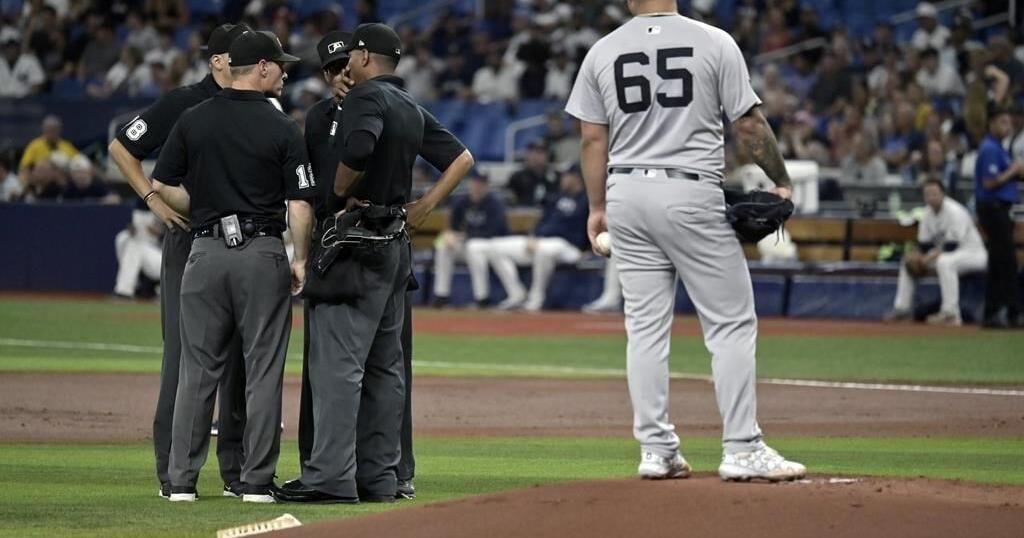ST. PETERSBURG, Fla. (AP) — Randy Arozarena hit a first-inning home run in a 5-4 victory for the Tampa Bay Rays on Thursday night as they took two of three from the Yankees and extended New York’s streak of winless series to eight.
Brandon Lowe’s RBI single put Tampa Bay ahead to stay in a three-run fifth against Nestor Cortes (4-8), and the Yankees lost for the 18th time in 25 games.
Austin Wells and Juan Soto homered for the Yankees, who have lost four straight series. The Yankees started 17-3-2 in their first 22 series but are 0-7-1 since winning three of four at Kansas City from June 10-13.
New York begins a three-game series at AL East-leading Baltimore on Friday night. The Yankees trail the Orioles by two games.
“Nobody likes losing, so nobody’s happy about it,” Yankees star Aaron Judge said. “But, we’re not feeling sorry for ourselves or sorry for anybody else because nobody else is. We’re going to play a first-place team right now, and we got to take these good at bats over to Baltimore.”
Soto went 2 for 3 with two walks and has reached bases at least three times in a majors-best 30 games but was in discomfort after a seventh-inning swing. His right hand has bothered him swinging since he got hurt June 28 at Toronto.
“They told me it’s nothing serious, which is going to go away by itself,” Soto said. “So, I’ve just go out there and try to do my job.”
Soto still plans to play in Tuesday’s All-Star Game.
Shane Baz gave up three runs and six hits over 4 1/3 innings in his second start since Tommy John surgery on Sept. 28, 2002.
Tampa Bay won its first home series against an AL East opponent since Sept. 4-6 against Boston and improved to 46-47.
Kevin Kelly (3-1) got two outs for the win and Pete Fairbanks allowed Ben Rice’s RBI single in the ninth before retiring Gleyber Torres on a popup for his 16th save in 18 chances and second of the series.
Second baseman José Caballero, sprinting with his back to the plate, caught Torres’ pop in short center as the ball stuck in the web of his glove. The ball popped out as he celebrated, but a video review upheld the out call.
“I was so excited that I caught the ball, and I hit my glove and it fell out,” Caballero said. “But I knew had it with me enough to be an out.”
Cortes allowed five runs and seven hits in 4 1/3 innings, dropping to 0-5 with a 6.04 ERA with a .301 opponents’ batting average on the road. He is 4-3 with a 1.81 ERA and .191 batting average at home.
Yankees pitching coach Matt Blake was ejected in the eighth inning after pinch-hitter Jose Trevino struck out with two on and one out following a questionable strike call by Edwin Moscoso on a 3-0 pitch,
“Frustrating ,but probably should have hit the 3-1,” Trevino said. “Nobody’s going to feel sorry for us. If anything, people want to see this, you know? ”
Judge went 0 for 4 with a walk and has gone eight games without an extra-base hit or RBI.
Arozarena’s home run gave the Rays a 2-0 lead in the first after center fielder Trent Grisham lost Yandy Díaz’s leadoff fly, which dropped for a double, but homers by Wells in the second and Soto in the third tied the score.
Lowe’s run-scoring single, Amed Rosario’s RBI double and Jose Siri’s sacrifice fly built a 5-2 lead in the third. Rice hit a sacrifice fly in the fifth.
New York went 1 for 9 with runners in scoring position and stranded 10 runners.
“We got the outs where we needed to get the outs,” Fairbanks said.
TRAINER’S ROOM
Yankees: 3B DJ LeMahieu had the night off, a day after he was hit on the left pinkie finger by a pitch and fouled a ball off his neck. Manager Aaron Boone said a CT scan on the neck was clean and LeMahieu could play on Friday.
UP NEXT
Yankees: RHP Gerrit Cole (1-1, 6.75 ERA) will make his fifth start Friday night against Baltimore and LHP Cade Povich (1-3, 6.51 ERA). The forecast in Baltimore calls for the potential of heavy rain
Rays: RHP Taj Bradley (3-4, 3.23 ERA) will face Cleveland RHP Carlos Carraso (3-6, 5.22 ERA) on Friday night.
___
AP MLB:























